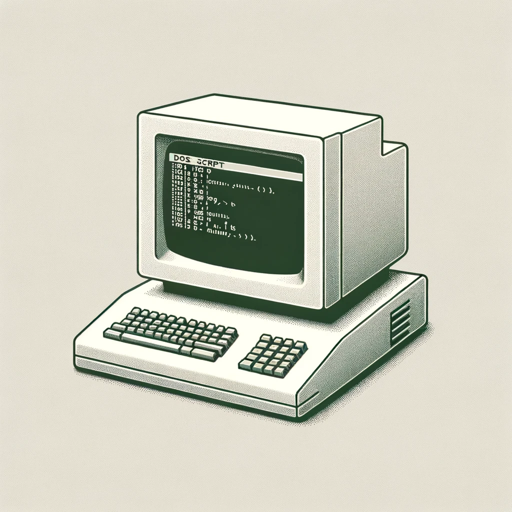Bash-AI-powered Bash scripting assistant
Automate tasks with AI-powered Bash scripts
Write a demo script in a multi-stage development
Write a demo script in a single-stage development
Show me an example prompt template
Give me a short example for all coding styles and stage development you know
Related Tools
Load More
Bash Shell Script
Your personal highly sophisticated Unix & Linux Bash scripting copilot, with a focus on efficient, scalable and high-quality production code.
Bash Shell Script Ace: Unix & Linux Guide
Your guide for Unix & Linux shell scripting, with learning and challenge modes.

Bash Scripting
Open Source Prompt: https://github.com/mleoca/Bash-Scripting-GPT

Linux Shell Guru
Linux Bash/Shell command expert, provides scripting assistance and explanations.

Batch Script Buddy
DOS Script expert aiding in batch file creation and optimization.

Terminal Guru
Your Linux and Bash terminal assistant for quick one-liners.
20.0 / 5 (200 votes)
Introduction to Bash
Bash (Bourne Again SHell) is a command-line interpreter or shell used in Unix-based operating systems. It was designed as a free software replacement for the Bourne shell (sh), offering advanced features and scripting capabilities while maintaining compatibility with traditional Unix commands. Bash's primary purpose is to allow users to interact with the operating system through commands, automate tasks via scripts, and manage files and processes efficiently. Bash scripts can range from simple command sequences to complex programs that manage system operations, automate routine tasks, and integrate with other software tools.

Main Functions of Bash
Command Execution
Example
Executing commands like `ls` to list directory contents or `cp` to copy files.
Scenario
A user needs to quickly navigate through directories and manage files using basic Unix commands. They can type commands directly into the Bash shell to perform these actions efficiently.
Scripting and Automation
Example
Writing a script to back up important files daily.
Scenario
An administrator writes a Bash script that automatically compresses and copies essential files to a backup location every night, ensuring data safety without manual intervention.
Text Processing
Example
Using `grep` to search for specific patterns in log files.
Scenario
A developer needs to find error messages in a large log file. They use Bash to run `grep 'ERROR' logfile.txt`, quickly isolating all relevant entries for troubleshooting.
Ideal Users of Bash
System Administrators
System administrators benefit from Bash by automating routine tasks, managing system resources, and configuring environments. Bash's flexibility allows them to write scripts that handle backups, user management, and monitoring services, making their workflow more efficient.
Developers
Developers use Bash to streamline their development process, manage version control systems, automate testing, and deploy applications. Bash scripts can integrate various tools, automate repetitive tasks, and simplify complex workflows, making it an essential tool for efficient development.

How to Use Bash
Visit aichatonline.org for a free trial
Start your Bash scripting journey without the need for login or ChatGPT Plus. Simply access the platform and begin exploring.
Install Bash
Ensure Bash is installed on your system. Most Linux distributions and macOS come with Bash pre-installed. For Windows, consider using WSL (Windows Subsystem for Linux) or Git Bash.
Open a Terminal
Launch your terminal application (e.g., Terminal on macOS, GNOME Terminal on Linux, or Command Prompt/PowerShell on Windows with WSL) to access the Bash shell.
Learn Basic Commands
Familiarize yourself with basic Bash commands like `ls`, `cd`, `echo`, `cat`, and `grep`. These are foundational for navigating and manipulating files and directories.
Write and Execute Scripts
Create Bash scripts by writing commands in a `.sh` file. Use the `chmod +x` command to make scripts executable, and run them with `./scriptname.sh`.
Try other advanced and practical GPTs
Bash Shell Script
AI-Powered Bash Scripting Tool

Cultural Translator Ads
AI-Powered Cultural Translation for Global Success.

Performance Ads Writer
AI-Powered Ads for Maximum Impact

Creative Writing
AI-Powered Creative Writing Assistant

Kahve Falı Uzmanı / Coffee Reading Expert
AI-powered coffee readings with a story.

Real Photo Maker
AI-driven image creation, effortlessly.

CCXT Crypto Code Wizard
AI-powered automated crypto trading

Chem Solver
AI-powered solutions for chemistry problems

Springboot Java / HTML / JS Expert
AI-powered full-stack development expert.
HTML CSS JS Web Dev Expert
AI-powered web development assistant.

Slang Savvy
AI-Powered Slang Translator

Budget - Financial Planning & Expense Tracking
AI-powered budgeting and expense tracking.

- Automation
- Networking
- Scripting
- Data Processing
- DevOps
Bash Q&A
What is Bash used for?
Bash (Bourne Again SHell) is a Unix shell and command language used for executing commands, automating tasks, managing files, and scripting on Unix-based systems.
How do you create a Bash script?
To create a Bash script, open a text editor, write your commands, and save the file with a `.sh` extension. Make it executable using `chmod +x script.sh` and run it with `./script.sh`.
What are some common Bash commands?
Common Bash commands include `ls` for listing files, `cd` for changing directories, `mkdir` for creating directories, `rm` for deleting files, and `grep` for searching text.
How can I debug a Bash script?
Use the `-x` option to run the script in debug mode (`bash -x script.sh`) or add `set -x` at the beginning of your script to trace command execution step-by-step.
What is the difference between Bash and other shells?
Bash is widely used due to its robust scripting capabilities and extensive documentation. Other shells like Zsh, Fish, and Ksh offer different features, syntax, or user interfaces.